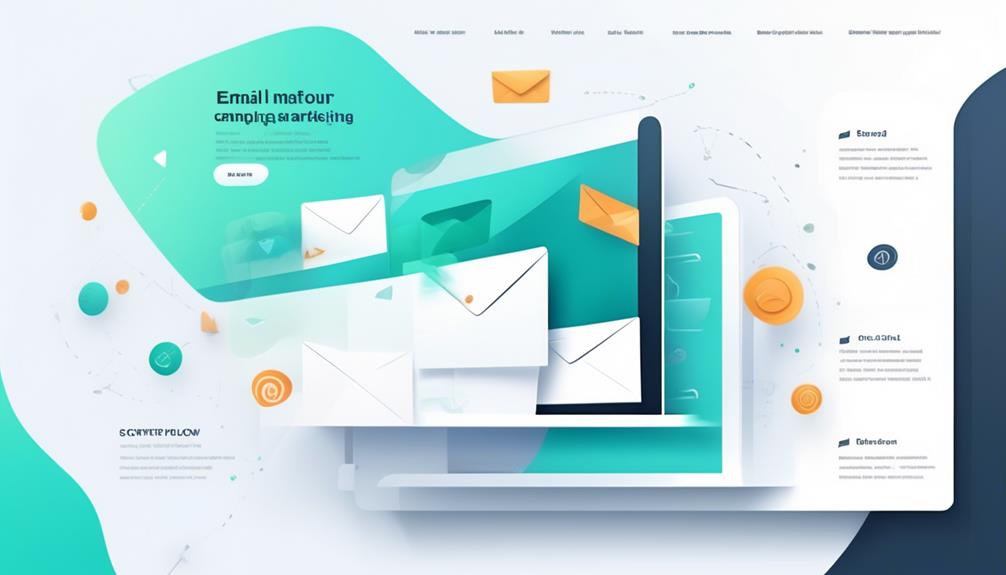Reaching out to college coaches brings with it the sensation of entering an unfamiliar arena – the excitement, the apprehension, and the aspiration to leave a memorable mark.
But how do you make sure your email stands out amidst the flood of messages they receive?
Well, let's just say there's a strategic game plan involved. And trust me, you'll want to stick around to learn the winning moves that will set you apart from the competition.
Key Takeaways
- Personalize your subject line and include essential details like name, graduation year, sport position, and location.
- Craft personalized emails that highlight admiration for the coach's achievements and the program's successes, mentioning specific details about the coach's program or team accomplishments.
- Demonstrate genuine interest in the coach's program by sharing specific reasons for being interested in the school or program and expressing passion for being part of their program.
- Showcase academic and athletic achievements, connecting them to how they align with the college's program, and present a compelling case for consideration.
Finding Coach Contact Information

To find coach contact information, we typically use the school athletic website, recruiting-specific software tools, or perform a Google search for the program. Accessing the coach's page on the school website is also a reliable method. Additionally, using specialized tools like ProductiveRecruit can provide quick access to the necessary contact information for college coaches.
When engaging in the recruiting process, having accurate and up-to-date contact details for coaches is crucial. This information usually includes the coach's email, phone number, and possibly their preferred method of contact. It's essential to ensure that the contact information obtained is from a credible and official source, such as the college's athletic department or official recruiting platforms.
Crafting an Effective Subject Line

Crafting an effective subject line requires thoughtful consideration of key details, such as your name, graduation year, sport position, standout achievements, and location. When sending an email to college coaches, the subject line is your first impression. It's the first thing they see, and it needs to grab their attention.
To craft a good subject line, it's time to personalize your approach. Use the coach's contact information to find the coach contact for the specific sport you're interested in. Keep the subject line concise while including essential details such as your name, graduation year, and sport position. Highlight a standout achievement, like an impressive 40-yard dash time or a noteworthy GPA. Adding your location (city/state) can also be beneficial.
Coaches receive numerous recruiting emails, so a well-crafted subject line can make your email stand out. Effective subject lines show that you've put thought and effort into your initial contact. Remember, the subject line is your first opportunity to make a positive impression, so take the time to personalize it for each coach you're emailing.
Personalizing Your Email
When writing an email to a college coach, it's crucial to personalize your message by using the coach's name and showing genuine interest in their program.
We want to make sure the coach knows that we've taken the time to research their team and accomplishments, and that we're genuinely interested in being a part of their program.
Use Coach's Name
In addressing Coach [Last Name], we aim to demonstrate our genuine interest in [University Name]'s [Sport] program and our appreciation for the opportunity to be considered as a potential addition to your team. Using the coach's name in the email adds a personalized touch and shows that we've taken the time to research and connect with the coach.
It's essential to address the coach directly to establish a connection and show respect. When sending the email, ensure that the use of the coach's name complies with NCAA rules. Mentioning specific details about the coach's program or team accomplishments can further demonstrate our interest and knowledge.
Personalizing the email by using the coach's name can create a positive impression and make the coach more likely to engage with our communication.
Show Genuine Interest
To demonstrate our sincere interest in [University Name]'s [Sport] program, we're committed to crafting personalized emails that highlight our genuine admiration for the coach's achievements and the program's successes. When sending an email to a college coach, it's crucial to show genuine interest in their program.
Here's how to express your interest effectively in the first email:
- Mention the coach's program and achievements to demonstrate your knowledge and admiration.
- Avoid using copied templates as personalized emails are more impactful.
- Share specific reasons for being interested in the school or program to show genuine interest.
- Express your passion for being part of their program and connect your interests outside of the sport as well.
Demonstrating Genuine Interest

We personalize each email to demonstrate our genuine interest in the college program, ensuring that our communication reflects our enthusiasm and specific knowledge about the opportunities it offers.
When contacting college coaches, it's crucial to go beyond generic emails and show a sincere interest in their program. Coaches can easily distinguish between a generic, mass-distributed email and one that's tailored specifically to their program. By including specific details about the athletic and academic opportunities offered by the college, we effectively communicate our genuine interest in being recruited.
Expressing enthusiasm for the program and the prospect of contributing to its success further demonstrates our commitment. Additionally, maintaining consistency in our communication across various channels, such as email and phone calls, reinforces our genuine interest in the college program.
It's also essential to make use of the coach's contact information to convey our interest in a personalized manner. By providing free access to athletic and academic information, we can express our genuine interest and dedication to the recruitment process.
Crafting personalized, well-researched emails and leveraging available resources, such as sample emails, are effective ways to demonstrate our genuine interest in the college program and our interest in being recruited.
Highlighting Academic and Athletic Achievements

Demonstrating genuine interest in the college program involves effectively highlighting academic and athletic achievements to capture the coach's attention and showcase our potential as a valuable addition to the team. When emailing college coaches, it's crucial to present a compelling case for consideration.
Here's how we can effectively highlight our academic and athletic achievements to make a lasting impression:
- Showcase our academic achievements, including our GPA, ACT score, and intended major. Highlighting our commitment to academic excellence demonstrates our ability to balance the demands of both athletics and studies, making us a well-rounded student-athlete.
- Share our athletic achievements, such as notable statistics, awards, and leadership roles within our high school or club team. These accomplishments provide tangible evidence of our skills, dedication, and potential contribution to the coach's team.
- Connect our achievements to how they align with the college's program and what we can bring to the team. By illustrating the correlation between our accomplishments and the team's goals, we emphasize our potential impact and value as a recruit.
- Mention any extracurricular activities or community involvement that further highlight our character, work ethic, and ability to contribute positively to the team dynamic.
Showcasing Video Highlights and Online Profiles

When reaching out to college coaches, it's important to highlight our video skills and athletic achievements. By creating an online profile on platforms like SportsRecruits, we can showcase our talents and engage with coaches.
Including a link to our highlight video in our introductory email provides a visual representation of our abilities and sets us apart from other potential recruits.
Highlighting Video Skills
Showcasing your best athletic skills and accomplishments through a personalized highlight reel and an online profile is a crucial step in catching the attention of college coaches. When highlighting video skills in your communication with coaches, it's essential to provide a comprehensive view of your abilities and potential.
Here's how you can effectively showcase your video skills and online profile to make a lasting impression on college coaches:
- Craft a highlight reel that captures your most outstanding athletic achievements and skills.
- Utilize online platforms like SportsRecruits to share your highlight video and athletic accomplishments, ensuring your contact information and academic stats are included.
- Use the SportsRecruits messaging system to keep communication with college coaches organized and transparent.
- Personalize your email with a link to your highlight video and online profile, providing coaches with a clear understanding of why you're a good fit for their program.
Linking Online Profiles
To effectively capture the attention of college coaches, we recommend creating a comprehensive online profile on platforms like SportsRecruits and including a link to your highlight videos showcasing your athletic abilities. College coaches need to know what you have to offer both on and off the field. In your online profile, be sure to include your academic achievements, as they play a crucial role in the college recruiting process. When coaches contact you, they want to see a well-rounded student-athlete. By sharing the link to your online profile in your email to the college coach, you make it easy for them to access all the information they need. Remember to regularly update your online profile with new accomplishments and videos to keep coaches informed about your progress.
| Key Point | Description |
|---|---|
| Comprehensive Profile | Include academic achievements and highlight videos showcasing athletic abilities in the online profile. |
| Coaches Contact | Make it easy for coaches to access information by sharing the link in your email. |
| Regular Updates | Keep coaches informed about your progress by regularly updating your online profile with new accomplishments. |
| Well-Rounded Athlete | Coaches want to see a well-rounded student-athlete, so be sure to showcase both your academic and athletic abilities. |
Sharing Athletic Achievements
After creating a comprehensive online profile and linking it in your email to the college coach, the next step is to highlight your athletic achievements, including video highlights and academic information.
When sharing your athletic achievements, you should:
- Showcase your skills through a professionally edited highlight reel that captures your best moments on the field or court.
- Provide links to your athletic website or profiles on platforms like SportsRecruits to offer coaches a more detailed view of your accomplishments.
- Include your GPA and test scores to demonstrate your academic capabilities and commitment to excellence in the classroom.
- Make it easy for coaches to contact you by including your contact information and inviting them to reach out for further discussion.
Including Contact Information and References

When reaching out to a college coach, it's important to provide your full name, graduating class, and sport position in the introduction, along with your contact information and references for further evaluation. This includes your email address and phone number so that the coach can easily reach out to you.
Additionally, offering references from your current coach or other relevant individuals can provide the coach with valuable insights into your character and abilities. It's also essential to mention details about your high school and club team, as this gives the coach a better understanding of your athletic background and experiences.
Personalizing the email by including specific academic and athletic achievements can further showcase your potential as a student-athlete. When providing contact information, be sure to use a professional email address and a reliable phone number.
Setting Up Your Email Signature

As student-athletes, we can enhance the professionalism and impact of our communication with college coaches by creating a comprehensive and polished email signature.
When setting up our email signature, we should consider the following:
- Full Name: Including our full name in the email signature adds a personal touch to the communication and ensures that the coach knows exactly who they're corresponding with.
- Graduation Year: Adding our graduation year provides coaches with important information about our academic standing and helps them understand our timeline for potential enrollment.
- Sport and Position: Clearly specifying our sport and position in the email signature helps coaches identify our athletic abilities and determine if we're a good fit for their team.
- Contact Information and NCSA Profile: Providing our contact information, including our phone number and email, makes it easy for coaches to reach out. Additionally, including a link to our NCSA profile or other athletic or academic profile can further showcase our skills and achievements.
Sending and Tracking the Email
To effectively engage with college coaches, it's essential to carefully manage the process of sending and tracking our emails, ensuring that we maintain a professional and organized approach. When sending emails to coaches, it's crucial to keep track of the sent emails to each coach and the dates. This helps in following up and maintaining a record of communication. Additionally, using the read receipt function can provide insight into whether coaches have opened your email, giving you an indication of their level of interest.
To ensure the professionalism of your emails, save the email as a draft before sending to double-check everything, including your contact information and a professional email address. In case there's no response, it's advisable to follow up the email with a phone call to the coach. This demonstrates your proactive approach and commitment to establishing a connection.
Remember to include your high school and club coach's contact information in the email to provide the college coach with additional references. By carefully tracking the email communication with college coaches, you can stay organized and increase the likelihood of receiving a response.
Is the Format for Writing an Email to a College Coach Similar to Writing an Email to a Counselor?
Yes, the format for writing an email to a college coach is similar to writing an email to a counselor. Both require a professional tone, clear introduction, and specific purpose. Whether seeking athletic guidance or academic advice, writing an email counselor or coach should be concise and respectful.
Frequently Asked Questions
How Do You Write an Email to a College Coach?
We write an effective email to a college coach by showcasing our genuine interest and potential.
It's crucial to personalize the email and highlight academic and athletic achievements.
Crafting a captivating subject line with key details and providing clear action items for the coach sets the stage for successful communication.
Utilizing professional platforms like SportsRecruits helps organize communication and showcase our profile effectively.
How Do You Introduce Yourself to a College Coach?
When introducing ourselves to a college coach, we aim to make a strong first impression. We personalize our email to express genuine interest in the coach's program.
Highlighting our academic and athletic achievements helps grab the coach's attention. We provide a clear call to action, such as inviting the coach to watch us play.
Double-checking for any errors in spelling or grammar is crucial before hitting send.
Is It OK for a Parent to Email a College Coach?
Yes, it's okay for a parent to email a college coach. However, it's important to remember that the athlete should take the lead in the recruiting process.
A parent's email can be helpful in initiating contact, but the coach will want to communicate directly with the athlete.
The parent's email should support the athlete's efforts and not overshadow their role in the recruitment process.
When Should You Start Emailing College Coaches?
We typically begin emailing college coaches during our sophomore year to introduce ourselves and express our interest in their program. This allows us to start building a relationship early on and gives coaches a chance to familiarize themselves with us as potential recruits.
It's important to be proactive and strategic in our communication to showcase our skills and dedication to the sport. Starting early can make a significant difference in the recruiting process.
Conclusion
In conclusion, when writing an email to a college coach, it's crucial to craft a captivating subject line, personalize the content, and showcase academic and athletic achievements.
By setting up a professional email signature and including contact information and references, you can demonstrate your genuine interest in being recruited.
Remember to send and track your email to ensure it's received.
With these tips, you can effectively grab a coach's attention and increase your chances of being noticed.










